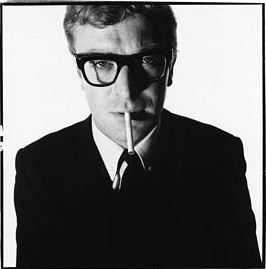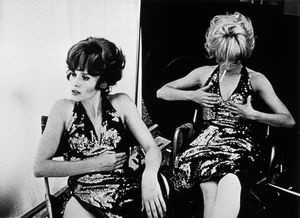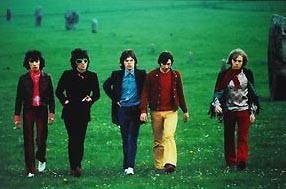The image of COOL

Michael Caine, maj 1965
Foto: David Bailey
In Sweden David Bailey is most well known as Swinging London’s own rebellious court photographer. His camera brought together the fashion, music, idioms and life style of the early 1960’s in photographs that both revolutionised fashion photography and drew the surrounding world’s attention to Great Britain. In that way David Bailey has more than any other photographer both captured and formed an epoch with his photographs. Today David Bailey is still one of the photographers who attracts most attention in the world and he has kept his instinctive feeling for “cool”. Moderna Museet shows one of his rare exhibitions, where he has selected the photographs himself.
The exhibition David Bailey – photographs begins in the 1950’s and ends in the late 1990’s. But above all it focuses on the epoch where London was the centre of a new culture and life style and where David Bailey himself was one of the prime movers. Under British flag jazz turned into white pop, close-cropped boy’s necks became long-haired, models thinned and fashion shrunk the skirts shorter than ever before in history. At the same time new ground was broken for architecture, design, graphics and imagery. Great Britain suddenly strongly attracted young people from all over Europe and the US and in that way “Swinging London” came to be an important part in shaping the popular culture in which we live today.

Francoise Dorléac och Catherine Deneuve, 1966
Foto: David Bailey
This turbulent period in time coincided with David Bailey’s breakthrough as a photographer. In front of his camera the celebrities of the new time passed by, among them Mick Jagger, Marianne Faithful, Mary Quant and Twiggy. In the gallery of characters there was also place for authors, actors and gangsters with a cool attitude as the least common denominator.
But above all it is the beautiful women that make David Bailey a distinctive and successful photographer. In 1960’s London he discovered and brought out new qualities in his models by placing them in other settings than the conventional environment of the studio. He brought them out into the bustling city and directed one model after another on street corners, by walls of houses and in parks. The result was photographs that with their rhythm and presence seem to be one with the city and the surrounding world, and this was totally new at this time. With that David Bailey’s breakthrough was a fact and in his cocky way he let it be understood that his primary driving force as a photographer was the sexual relations with beautiful women.
David Bailey was born in 1938 and grew up in London’s East End, an area that at this time was one of the poorest and most effected by criminal in the city. Early he showed signs of being a survivor who despite his dyslexia and his catastrophic school grades made his way in life. As a boy he became aware that there was another kind of life than the family’s hardships in the East End. In Fred Astaire’s Hollywood movies he discovered a glamour and luxury that would imprint his dreams about the future.
Another one of David Bailey’s idols was the American trumpet player Chet Baker who had an as relaxed as incredibly beautiful way of playing – not unlike the atmosphere in the photographs that Baker’s young admirer would create. David Bailey got himself a trumpet that he brought when he as a teenager was placed in Singapore for RAF (the Royal Army Forces). The instrument was stolen but at the same time he discovered photographic magazines like Life Magazine and that resulted in him buying a second-hand camera. Back in London he was employed at the age of 20 by the fashion magazine Vogue, something that in itself was amazing. No one in the fashion industry had until then paid any attention to Great Britain, not to mention that no one had ever heard of a young photographer called David Bailey.

The Rolling Stones, 1968
Foto: David Bailey
But for different reasons things started to happen in British fashion and music and “Swinging London” was soon a concept for an entire generation of young people. David Bailey was at the centre of events and photographed himself in a just as cool as distinguished circle of friends where his cocky attitude – that would today be labelled streetwise – was a new and exciting ingredient in society life. His identity as working class seemed to be both impossible and unnecessary to hide.
With all likeliness it was David Bailey’s closeness to the talk of the town, to what was happening that was one of his greatest assets during this period. He saw trends and tendencies on the street before others discovered them. He borrowed the attitude of the mods and the poses of the male pop stars and applied it on his models in the fashion reports and he excelled in the art of transforming a sophisticated upper class girl into a considerably more provocative beatnik girl.
Traces of David Bailey’s great impact during the 60’s are still evident today. His photographs have still importance for the design of album covers, fashion reports and the ideal of female beauty and this is directly linked to “Swinging London”. And the younger generation’s perception of this epoch is greatly influenced by these photographs.
For almost four decades David Bailey has also kept his own image alive – as a seducer, rebel and as a man with a huge self-confidence. With cocky statements scattered between fabulous photographs he has kept his claimed place on the public scene. But if you as a viewer of his photographs manage to go beyond the myth of “sex and drugs and rock’n’roll” you discover a photographer with a rare feeling for the absolute contemporary and the characters that made and still make their “cool” imprint on it.
Text: Annika Hansson/goodword production
